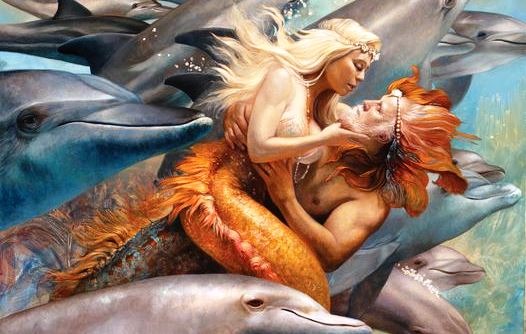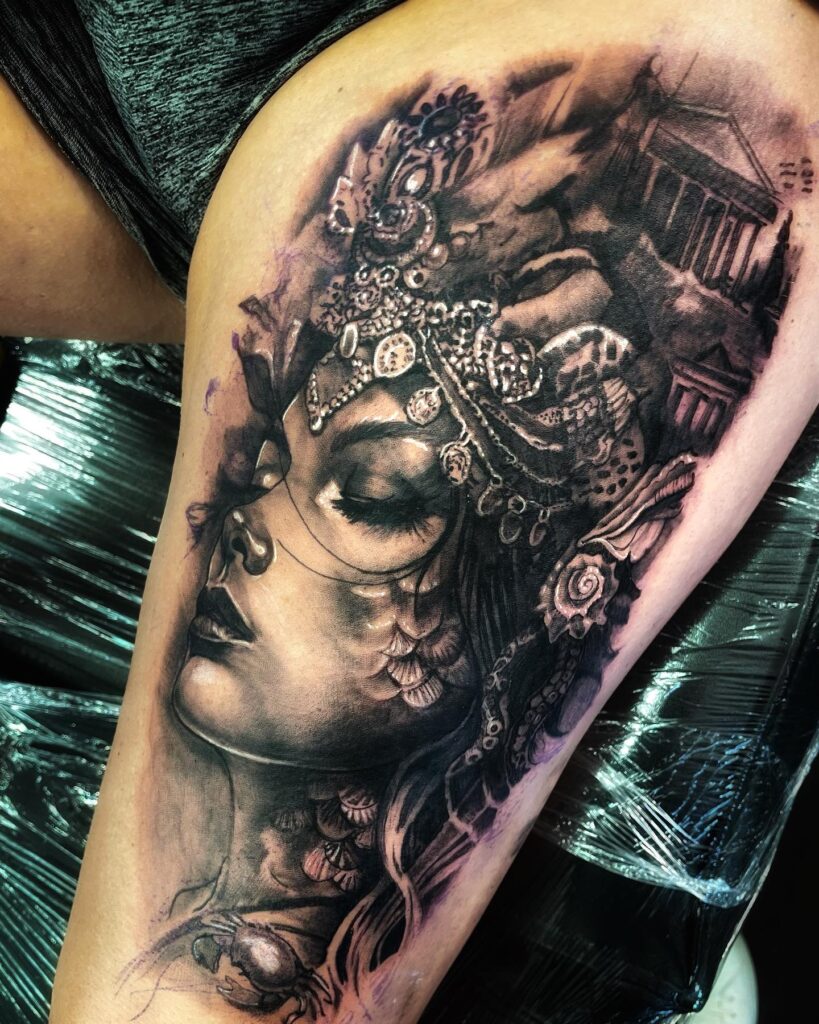Table of Contents
Amphitrite is a figure from Greek mythology. She is primarily known as the sea goddess and the wife of Poseidon, the god of the sea. Amphitrite is often depicted as a beautiful and graceful sea nymph or goddess, and her name is sometimes associated with the sea itself. She is a relatively minor deity in Greek mythology compared to some of the more well-known gods and goddesses, but she plays an important role as the queen of the sea and the consort of Poseidon.
Amphitrite is often represented riding a chariot pulled by sea creatures, typically dolphins or sea horses. She is also linked to the imagery of the ocean and its vastness. While her stories and attributes are not as extensive as some other Greek deities, she symbolizes the power and majesty of the sea in Greek mythology.
Amphitrite pronunciation
- AM-fuh-tryt
Here’s a breakdown of the pronunciation:
- The first syllable, “AM,” is pronounced as in the word “am” or “ham.”
- The second syllable, “fuh,” is pronounced with a short “u” sound as in “fun.”
- The last syllable, “tryt,” is pronounced as it appears, with the emphasis on the “try.”
English pronunciation can vary slightly based on regional accents and dialects, but the pronunciation provided here is a close approximation of how “Amphitrite” is generally spoken in English.
Origin Of Amphitrite
Amphitrite’s name is derived from the Greek words “amphi,” meaning “around” or “on both sides,” and “triton,” meaning “third.” The name likely alludes to her association with the sea, which surrounds and encompasses both land and the depths of the ocean.
Amphitrite’s role as the wife of Poseidon, the god of the sea, and her significance as the queen of the sea made her an important figure in maritime mythology. She is often depicted as a graceful and beautiful sea goddess, riding a chariot drawn by sea creatures.
Her stories and attributes were further developed in various Greek myths and poems, highlighting her role as a sea deity. While Amphitrite is not as prominent as some other Greek gods and goddesses, her presence in Greek mythology reflects the ancient Greeks’ deep connection to the sea and their desire to personify and honor its power and beauty through mythological figures.
Family of Amphitrite
Triton: Triton is the most famous son of Amphitrite and Poseidon. He is often depicted as a merman with the upper body of a human and the lower body of a fish. Triton is known for his role as a sea messenger and the blowing of a conch shell to calm or stir the waves.
Rhodos: Rhodos is sometimes mentioned as the daughter of Amphitrite and Poseidon. She is associated with the island of Rhodes and is the namesake of the island’s mythology and history.
Benthesicyme: In some accounts, Benthesicyme is listed as a daughter of Poseidon and Amphitrite. Her stories and attributes are not as widely known as those of Triton.
Amphitheus and Cymopoleia: In some traditions, Amphitrite and Poseidon are mentioned as the parents of Amphitheus and Cymopoleia, who are lesser-known sea deities.
The family relationships in Greek mythology can vary in different accounts and sources, and not all traditions may include the same children for Amphitrite and Poseidon. Nonetheless, Amphitrite’s primary role in Greek mythology is that of the queen of the sea and the wife of Poseidon, which makes Triton, her son, one of the more well-known and prominent figures associated with her.
Amphitrite in Modern Influence
Amphitrite, as a figure from Greek mythology, has had a limited direct impact on modern culture compared to some other Greek deities. However, her influence can still be observed in various ways, particularly in literature, art, and nautical themes. Here are some examples of modern influence related to Amphitrite:
Art and Sculpture: Amphitrite has been a subject of artistic representation for centuries. Her image, often depicted as a graceful sea goddess, continues to inspire sculptures, paintings, and other works of art that celebrate the beauty and power of the sea.
Literature: Amphitrite and her association with the sea are occasionally referenced in literature, particularly in poetry and novels with maritime themes. Her name may be evoked in literary works that explore the mysteries and allure of the ocean.
Maritime and Nautical Imagery: Amphitrite’s connection to the sea is reflected in various maritime and nautical references, such as the use of her name for ships, underwater exploration, and even modern maritime organizations.
Aquatic Research and Exploration: The exploration of the world’s oceans and underwater environments often involves references to Greek mythology, including Amphitrite. Her name might appear in the context of oceanography and marine biology.
Submarine Naming: In modern naval traditions, submarines have been named with references to Amphitrite and other sea-related mythological figures.
While Amphitrite may not be as well-known or prominent in modern culture as some other Greek deities, her enduring connection to the sea and the maritime world ensures that her influence continues to be felt in various artistic, literary, and nautical contexts.
Amphitrite as Poseidon wife

Amphitrite is indeed the wife of Poseidon in Greek mythology. Their union is a central aspect of Greek mythological stories related to the sea and the ocean. Poseidon, the god of the sea, and Amphitrite, a sea goddess, are considered a divine couple, symbolizing the rulership of the sea. Amphitrite’s role as the queen of the sea complements Poseidon’s authority over the waters. Their relationship underscores their joint dominion over the oceans and the depths of the sea in Greek mythology.
Amphitrite tattoo
Depiction of Amphitrite: You can choose to depict Amphitrite herself in the tattoo. She is often represented as a graceful sea nymph or goddess, riding a chariot drawn by sea creatures like dolphins or sea horses. Consider the style and pose you prefer, whether it’s a full-figure representation or a more symbolic one.
Poseidon and Amphitrite: Another option is to depict both Poseidon and Amphitrite together. Their union symbolizes the rulership of the sea. This can create a more dynamic and meaningful design, especially if you have a strong connection to both figures.
Sea and Ocean Elements: Incorporate sea-related elements such as waves, seashells, coral, or other marine life to complement the Amphitrite theme and add more depth to the tattoo.
Color Palette: Consider the colors you want in your tattoo. Oceanic blues and greens, as well as earthy tones, can create a beautiful aquatic atmosphere in your design.
Placement: Think about where you want to place your tattoo. Common locations for ocean-themed tattoos include the upper arm, shoulder, back, calf, or thigh. The size and intricacy of your design may also influence the placement.
Style: Decide on the tattoo style that suits your personal taste. You can go for a realistic, illustrative, or more symbolic and abstract design.
Symbolism: Consider the personal symbolism you want to associate with your Amphitrite tattoo. It may represent your love for the ocean, your connection to water as an element, or an appreciation for mythology and ancient stories.
Consult with a Tattoo Artist: Once you have a clear idea of the design you want, it’s important to work with a professional tattoo artist. They can help refine your concept, ensure the design fits your chosen body placement, and bring your idea to life.
Remember that a tattoo is a permanent commitment, so take your time to choose a design and artist that resonates with you. It’s also a good idea to research and view the artist’s portfolio to ensure they can create the style you’re looking for.







